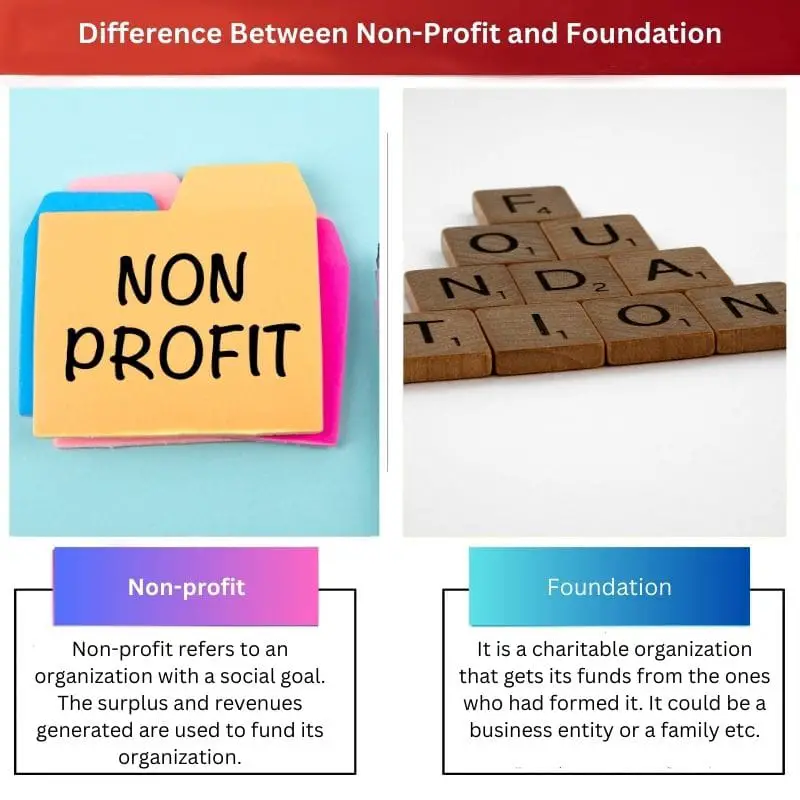The organization is a much-heard word nowadays. Simply put, it is an organized group of people that aims to help people.
Its main aim is to help less fortunate ones. Organizations are further divided into various groups based on how they are formed and governed. Non-profits and foundations are two of those groups.
Key Takeaways
- A non-profit organization is formed for a specific social or charitable cause, while a foundation is set up to provide grants or scholarships.
- Non-profit organizations are focused on fulfilling their mission, while foundations are more focused on investing their assets to generate income for their charitable purposes.
- Non-profit organizations rely on donations and volunteers to operate, while foundations are funded by an endowment and have a staff to manage their operations.
Non-profit vs Foundation
NPOs are organizations established for social or charitable goals, run by a board of directors, and income is used to fulfil objectives, not for distribution to owners or shareholders. A foundation is a non-profit organisation supporting a specific charitable cause or organization. Donations from individuals, families, or corporations fund foundations.

As the name suggests, non-profit organizations are legal groups organized and operated to help people. To further a social cause. The profit used is solely used for the benefit of others.
On the other hand, Foundation is a charitable organization that gets its funds from its founders. It also grants funds to the non-profit organization.
Comparison Table
| Parameters of Comparison | Non-profit | Foundation |
|---|---|---|
| Definition | Non-profit refers to an organization with a social goal. The surplus and revenues generated are used to fund its organization. | A charitable organisation gets its funds from the ones who formed it. It could be a business entity or a family etc. |
| Sources of Funds | Funds derived from government, foundations, individuals, etc | Funds derived from its founders. It could be a business firm, family, etc. Private foundations have to rely on private foundations or funds. |
| Grants | Does not make grants to other foundations or charities. | Make grants to other charities and non-profit organizations. |
| Taxation | Exempted from most of the individual and corporate taxes. | Private/family foundations are supposed to pay an excise tax of 1-2%. |
| Financial Information | NPOs share some basic but limited financial information. | Since it is self-funded, it solely depends on whether they want to share the information. |
| Employee benefits | Most of the staff at NPOs are volunteers. They don’t get paid. They are employed to work together for a good cause. | Employees are paid reasonable salaries. |
| Challenges | It mostly has to depend on other organizations for funds and donations. | They receive funds from the founders themselves. |
| Board Of Directors | Governed by a board of directors for proper functioning. | Governed mainly by its donors or a board consisting of family or other individuals. |
What Is a Non-Profit Organization?
A non-profit organization, also known as a non-profit institution, is a legal entity. It is aimed at working for a social cause and public benefit. They work under various categories: human services, art, culture, public and social benefits, etc.
These organizations require no government council but receive funds from governments, various institutions, individuals, etc. The surplus received is mainly funded by its operations. None of the members or employees get the benefit from the surplus.
Some major aspects of non-profits are accountability, trust, openness, etc. These are the building blocks of an organization. Every person who has invested his money, time, and faith should learn about the work. Isn’t it?

What is a Foundation?
The foundation is a charitable organization. It aims to fulfil its purposes by funding or mostly supporting individuals and other organizations by providing them funds as grants or gifts. The funds received are from the founder itself. Be it some business entity or family, etc.
Types of Foundations-
- Operating foundations– It deals with all sorts of charitable work. Distributes funds to its existing programs.
- Private Foundations– Owned and managed by the owners of the foundation, be it a family or a group of individuals.
- Public Foundations– They have to rely upon private foundations and corporations for funding.
- Non-operating Foundation– Foundation’s main task is to see after grants and funds for other charitable foundations.

Main Differences Between Non-Profit and Foundation
- The main difference between non-profit and foundation lies in the definition. The non-profit is associated with social causes and purposes. On the other hand, a foundation refers to a charitable organization whose founders are some corporate group, family, or individual.
- Non-profit organizations do not make grants to other charities. The surplus received by non-profits is used to fund its operation. Foundations make grants to other charities and working organizations.
- Employees of non-profit organizations are most probably volunteers. They don’t get paid for the work. Employees of the foundations get paid for their work.
- The taxation process is quite different in both cases. In the case of non-profit organizations, there is an exemption from tax. Be it individual or corporate taxes. On the other hand, foundations are supposed to pay a tax of 1-2%.
- As mentioned in the table, non-profit organizations release some basic financial information to show and verify the substantial support received from the public. Foundations may choose whether to give the details of finances because they are self-funded.
- Funding emerges to be an issue for non-profits. They depend mostly on grants offered by the government, foundations, and various other incorporation. A delay in funds turns out to be a problem. For funds, they don’t have to rely on others. They are self-funded.
- For the proper functioning of an organization, non-profits constitute a board of directors. In the case of a foundation, the board mainly comprises founders and family members.





